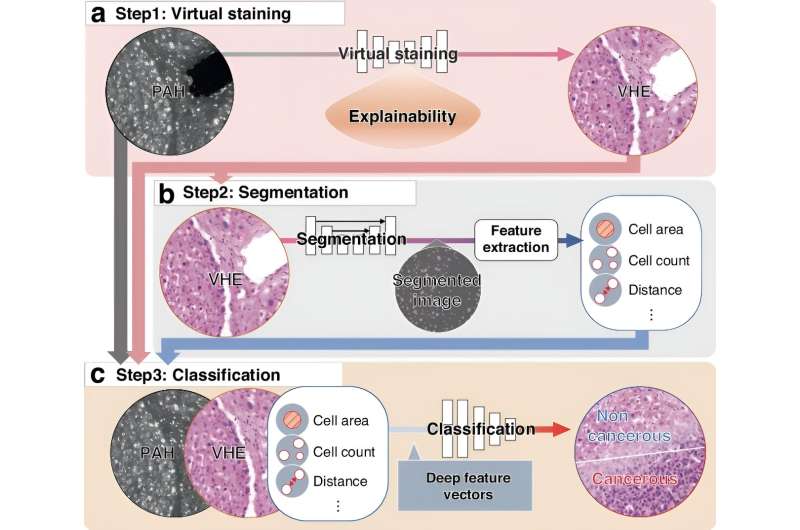This article has been reviewed according to Science X's editorial process and policies. Editors have highlighted the following attributes while ensuring the content's credibility:
fact-checked
peer-reviewed publication
trusted source
proofread
Beyond conventional pathology. Label-free histology meets AI

A collaborative research team led by POSTECH Professor Chulhong Kim and Professor Chan Kwon Jung of Seoul St. Mary's Hospital, Catholic University of Korea, has developed an artificial intelligence (AI) system to analyze the label-free photoacoustic histological images of human liver cancer tissues. Their research was recently published in Light: Science & Applications.
Histopathology is the primary source for diagnosing diseases and developing appropriate treatment plans. Typically, examining removed tissue under a microscope requires staining, which involves additional labor and cost due to the use of chemicals.
Photoacoustic histology (PAH) technology has been developed to mitigate these issues. PAH generates images by detecting sound (ultrasound) signals produced by biomolecules when illuminated with light (laser), thus eliminating the need for staining and labeling. However, PAH presented unfamiliar images to pathologists, complicating interpretation and diagnosis, and resulting in relatively low accuracy.
In this study, the researchers integrated PAH with cutting-edge deep learning models capable of virtual staining, segmentation, and classification of human tissue images.
Initially, the virtual staining step transforms black-and-white, unlabeled images—containing cell nuclei and cytoplasm—into images that mimic stained samples. This step is designed to produce images similar to actual stained samples while preserving tissue structures, and uses explainable deep learning methods to increase the reliability of the virtual staining results.
Next, during the segmentation phase, the unlabeled image and the virtual staining data are used to segment features of the sample such as cell area, cell count, and intercellular distances. Finally, in the classification phase, the model uses the unlabeled image, virtual staining image, and segmentation data to classify whether the tissues are cancerous or not.
The researchers applied their deep learning model to the PAH images of human liver cancer tissues. The AI model, which integrates virtual staining, segmentation, and classification, achieved a high accuracy of 98% in distinguishing between cancerous and non-cancerous liver cells. Notably, the model demonstrated a 100% sensitivity when evaluated by three pathologists, underscoring its potential for clinical application.
Professor Chulhong Kim, who led the study, stated, "The integration of PAH with AI reduces the time required for tissue biopsy and enhances its reliability." He added, "We hope this advancement will lead to more accurate diagnoses and more effective treatment planning for patients."
More information: Chiho Yoon et al, Deep learning-based virtual staining, segmentation, and classification in label-free photoacoustic histology of human specimens, Light: Science & Applications (2024). DOI: 10.1038/s41377-024-01554-7




















